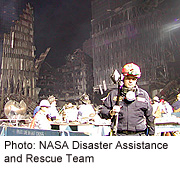
TUESDAY, Nov. 15 (HealthDay News) — First responders who were exposed to the dust cloud during and immediately following the New York City terror attacks on Sept. 11, 2001, may be at increased risk for heart disease, experts warn.
Those Ground Zero workers who got there first may have breathed in even more of this toxic dust than those who came on the scene after Sept. 13, and may be at greater risk for heart disease as a result, according to new findings slated for presentation Tuesday at the annual meeting of the American Heart Association in Orlando, Fla.
Researchers from the Mount Sinai School of Medicine in New York City examined the integrity of the blood vessel walls in 31 Ground Zero workers. The 19 men and women who were there during the first two days showed greater damage to their blood vessel walls than their counterparts who arrived later.
“The workers who inhaled particulate matter at Ground Zero, especially those within the initial ‘cloud,’ received a much higher ‘dose’ of particulate matter, compared with inhaling air pollution,” said study author Dr. Mary Ann McLaughlin, an associate professor of cardiology. These particles trigger inflammation in the lining of the artery walls (endothelium), which sets the stage for atherosclerosis (hardening of the arteries), she said.
The new study did not look at whether or not these workers had more heart attacks or strokes than people who were not exposed to the toxic dust. Co-author Dr. Venkatesh Mani, an assistant professor of radiology, said it made sense that individuals with this type of damage to their blood vessel walls may be more likely to have heart attacks and strokes. Given these findings, first responders may need to pay close attention to their other heart disease risk factors, Mani said.
“Apart from living a healthy lifestyle and regularly following up with their physicians for routine examinations for cardiac assessment, these individuals will also benefit from follow-up MRI imaging on a regular basis, maybe once a year, to examine progression/regression of their [blood vessel] disease,” he said.
Dr. Gordon F. Tomaselli, American Heart Association president, said exposure to particulate matter in the air and urban living do increase risk of atherosclerosis, but less is known about how long the exposure must last to do such damage. There are other unknowns about the exposures that took place at Ground Zero on Sept. 11 and beyond, he said.
“Rescue workers were under horrific psychological stress and this may have led them to change their behaviors,” Tomaselli said. “The stress could have led to greater incidence of smoking and/or other unhealthy behaviors.”
The first responders who rushed in to help may have also been less prepared than those who came on the scene during subsequent days and wore masks that could have limited their exposure, Tomaselli added.
“More exposure plus less protection equals greater risk,” said Dr. Stephen Kopecky, a cardiologist at the Mayo Clinic in Rochester, Minn. “The ones who were there early had a very high exposure to the particulate matter and there is a difference in their arteries,” he said.
Dr. Elliott M. Antman, a professor of medicine at Harvard Medical School in Boston, likened this level of exposure to “many years of cigarette smoking compressed over time.”
Because this study was presented at a medical meeting, the data and conclusions should be viewed as preliminary until published in a peer-reviewed journal.
More information
The U.S. National Institutes of Health has more on atherosclerosis.

